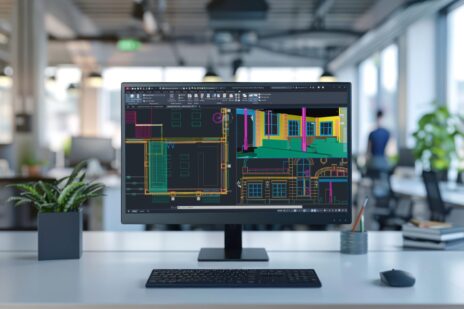
3D mapping technology–also called 3D projection mapping or spatial augmented reality–is a technology used to project a 2D or 3D object onto a display surface through spatial mapping. 3D mapping is often used by advertisers and artists to add dimension, movement, and depth to previously static objects such as buildings or stages. One of the first public displays of projections onto 3D objects was debuted in 1969, when Disneyland opened their Haunted Mansion ride. Head shots of singers were filmed on 16mm film and then projected onto busts of their faces to make them appear animated.

How It’s Done
All projection mapping starts with a concept. Key considerations are the location of the spectator area and of course, what object you want to projection map. Most often, this is a building. From there, you can use AutoCAD to create 3D models of the projection mapped objects. These 3D models will form the basis of the mapping, so it’s important that they are accurate. Often laser scans are used to capture precise measurement and dimensions for the mapping.

After completing the 3D model of the projection mapped object, a process called UV mapping converts the object into a surface capable of “receiving video,” in software terms. The UV map defines which pixels of the 2D video file will fall where on the 3D object and is critical to modern projection mapping workflows.
When the UV mapping is complete, the 3D object file can be loaded into a projection simulation tool. This tool simulates the position of the projectors and projection mapped object to see the behavior of the projection pixels. Advanced tools also include simulation of light level (luminosity) to enable photometric calculations to understand just how much light will be visible on the object during the projection show. At this point, projection designers can design the optimum projector setup, choosing projector lenses and stacking configurations.
Now it’s time for content production. The projection design will influence the overall resolution of the content, which can be produced using the same UV mapped 3D file. Content production methods vary widely from analog stop-motion graphics to real-time rendered effects using 3D content tools.
Whatever the content source is, you’ll also need a media server to play back the created content and manage onsite alignment and blending. It’s helpful to have software that can support multiple editors working simultaneously on the same file, so while the content team works on updates in the 3D simulation engine, the technical delivery team onsite can match the virtual 3D model with the real-world model, including moving the virtual projectors into place.
3D Projection Mapping in Practice
The technique of projection mapping dates back to the late 1990s, coming to prominence through guerrilla advertising campaigns and video jockeys for electronic musicians. Today, there is a growing resurgence with more and more companies creating campaigns for their products in cities across the world that employ 3D projection mapping. These advertising campaigns enlist the professional services and expertise of 3D projection mapping artists, like Andrei Snobar, owner and founder of Andrei Visuals.
Back in 2010, Snobar was your typical architecture student studying at German Jordanian University, a public university located near Madaba, Jordan, where he learned AutoCAD. Three years later, while studying abroad in Germany, Snobar attended the Berlin Festival of Lights and saw 3D projection mapping for the first time. Shortly after graduating, Snobar decided to quit working as a traditional architect and started his own 3D projection mapping business. Working with international companies from a variety of industries, including retail and banking, he uses AutoCAD to scale the renderings of a building’s façade before exporting it to Autodesk Maya, a 3D computer animation software. Snobar is Jordan’s leading 3D projection mapping artist, recently earning acclaim at Ibiza’s annual Light Festival. Read more of his story here.
While 3D projection mapping is costly—with the price of projectors ranging from 10K to 300K+—it’s also a burgeoning business. The global projection mapping market is expected to reach USD 3.56 billion by 2023, according to a report by global research firm MarketsandMarkets.
Learn more about how you can use AutoCAD for 3D mapping here.



